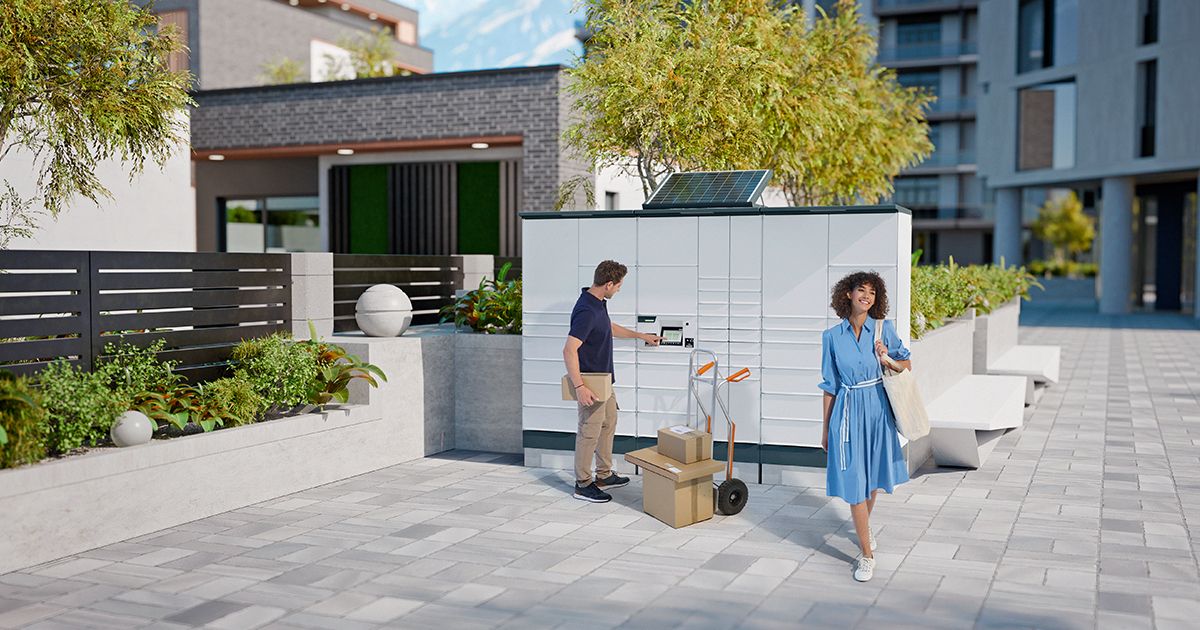5 urban legends about solar-powered lockers
- News
- 3.6.2025
- Reading Time: {{readingTime}} min

Contents
Modern lockers are flexible and efficient
This is exactly where solar lockers come in. They are self-sufficient, eliminating the need for grid connection costs or structural measures, and their operating costs are much lower than those of conventional lockers. Thanks to efficient technology, a single solar panel is enough to power a standard locker with up to 80 compartments in the case of loxmate, for example. If needed, up to five panels can be connected, allowing the locker to operate reliably even in locations with limited sunlight.
One important factor: the farther north a location is, the fewer sunlight hours it typically receives, and the lower the angle of solar incidence. loxmate is designed precisely for such conditions. The solar technology is configured so that the locker functions reliably even under poor lighting conditions – even in the "worst-case scenario." And we know it works: loxmate has already been successfully tested as far north as Vilnius.
Yet despite all these advantages, many urban legends about solar technology in the locker sector still persist. We take a closer look at the five most common misconceptions and reveal what’s really true.
"Modern solar lockers like loxmate require extremely little energy. Just one hour of sunlight is enough to power the locker for 30 days."
Urban legend 1: „Solar lockers don’t work in bad weather.“
A widespread misconception. Modern solar lockers, such as those in the loxmate series, require extremely little energy. The 100 Wp PV panel generates, under full sunlight, enough energy in just one hour to operate loxmate for up to 7 days.
The battery capacity is sufficient to power the locker for up to 30 days in complete darkness. In other words: Even if the sun doesn’t shine for several days, the locker still works. That’s exactly what makes solar lockers so attractive for year-round use – even in regions with long winters and overcast skies.
Urban legend 2: „Solar locker are only greenwashing.“
Incorrect. The environmental benefit is measurable. The CO₂ footprint of a solar-powered locker is approximately 20% better than that of a grid-connected device. Choosing a battery-powered locker instead actually performs worse in terms of CO₂ emissions, since replacement batteries must be regularly changed and recharged. That consumes resources and time.
Moreover, the cyclical replacement of batteries leads to additional monitoring, planning, and labor requirements. On top of that, large and heavy batteries are roughly 10 times more expensive than a solar panel.
Urban legend 3: „Solar lockers are expensive.“
On the contrary. The solar locker stands out with significantly lower operating and service costs. Depending on usage, a solar locker can save between €1,500 and €2,000 in electricity costs over its lifetime compared to a grid-powered unit. And of course, this is clearly reflected in the Total Cost of Ownership (TCO).
Urban legend 4: „Solar-powered lockers are dangerous.“
That’s not true either. Solar lockers operate with low voltage. This means there is no danger to people or animals—neither during operation nor maintenance. That’s a clear advantage, especially in residential areas, near schools, or in publicly accessible locations.
In connection with the safety of parcel lockers, we’d also like to highlight the KePol Child Safety feature: our lockers are designed in such a way that accidental locking-in is impossible—even in energy-saving mode. loxmate comes with this feature built in by default.
Urban legend 5: „The installation is complicated“
Not with solar lockers. For off-grid lockers with PV modules, our customers often opt for a concrete base. These can be installed as freestanding units without any site preparation. This means: no power connection and no civil engineering work, which allows for a simple and fast commissioning process. And that’s a clear advantage when new locations are being tested or need to be set up at short notice.
Because what matters most is that end users actually use the locker. The current trend is: “closer to the customer” – ideally so close that people can pick up their parcels in their slippers. Especially in cities and densely populated areas, there is a growing focus on smaller stations placed directly within residential environments.
Whether a location is truly accepted, however, only becomes clear in real-world operation. And this is where the solar locker shows its strength: since it requires no site preparation, it can be deployed and relocated flexibly. Perfect for testing new locations simply and effortlessly.
Why loxmate stands out
In this article, we’ve taken a closer look at five persistent myths surrounding solar-powered lockers—and debunked them. One thing is clear: this technology is not only practical, but also offers real advantages in terms of cost, sustainability, and flexibility. With the loxmate solar locker, KEBA demonstrates how autonomous parcel lockers can operate reliably even under challenging conditions. All of this comes with the trusted reliability KEBA has stood for over decades.
Curious whether solar lockers could be a good fit for your locations? Then get in touch with us. We’ll show you just how easy it is to get started—and how you can benefit in the long run.






